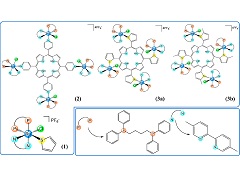Remarkable electronic effect on the meso-tetra(thienyl)porphyrins.
LEITE, Taíse H. O.; GRAWE, Gregory; HONORATO, João; CUNHA, Beatriz N.; NASCIMENTO, Otaciro Rangel; VARGAS, Pamela S.; DONATONI, Carolina; OLIVEIRA, Kleber T.; LOPES, Jefferson M. S.; BARBOSA NETO, Newton M.; MOREIRA, Wania C.; DINELLI, Luis R.; BATISTA, Alzir A.
LEITE, Taíse H. O.; GRAWE, Gregory; HONORATO, João; CUNHA, Beatriz N.; NASCIMENTO, Otaciro Rangel; VARGAS, Pamela S.; DONATONI, Carolina; OLIVEIRA, Kleber T.; LOPES, Jefferson M. S.; BARBOSA NETO, Newton M.; MOREIRA, Wania C.; DINELLI, Luis R.; BATISTA, Alzir A.
 Abstract: Complexes derived from meso-tetra(thienyl)porphyrins (TThP) and meso-tetra(pyridyl)porphyrin (TPyP) containing peripheral ruthenium complexes with general formulas {TPyP[RuCl(dppb)(5,5'-Mebipy)]4}(PF6)4, {TThP[RuCl(dppb)(5,5'-Mebipy)]4}(PF6)4, and {TThP-me-[RuCl(dppb)(5,5'-Mebipy)]4}(PF6)4 [5,5'-Mebipy = 5,5'-dimethyl-2,2'-bipyridine and dppb = 1,4-bis(diphenylphosphino)butane] were synthesized and characterized by spectroscopy techniques (1H- and 31P{1H}-NMR, IR, UV/vis, fluorescence, and electron paramagnetic resonance (EPR)), cyclic voltammetry, coulometry, molar conductivity, and elemental analysis. Voltammetry and UV/vis studies demonstrated differentiated electronic properties for ruthenium appended with TThP and TThP-me when compared to ruthenium appended with TPyP. The UV/vis analysis for the ruthenium complex derived from TThP and TThP-me, as well as the Soret and Q bands, characteristics of porphyrins, showed a band at 700 nm referring to the Ru ? S electronic transition, and porphyrin TThP-me showed another band at 475 nm from the Ru-N transition. The attribution of these bands was confirmed by spectroelectrochemical analysis. Cyclic voltammetry analysis for the ruthenium complex derived from TPyP exhibited only an electrochemical process with E1/2 = 0.47 V assigned to the Ru(II)/Ru(III) redox pair (Fc/Fc+). On the other hand, two processes were observed for the ruthenium complexes derived from TThP and TThP-me, with E1/2 around 0.17 and 0.47 V, which were attributed to the formation of a mixed valence tetranuclear species containing Ru(II) and Ru(III) ions, showing that the peripheral groups are not oxidized at the same potential. Fluorescence spectroscopic experiments show the existence of a mixed state of emission in the supramolecular porphyrin moieties. The results suggest the formation of Ru(II)-Ru(III) mixed valence complexes when oxidation potential was applied around 0.17 V in the {TThP[RuCl(dppb)(5,5'-Mebipy)]4}(PF6)4 and {TThP-me-[RuCl(dppb)(5,5'-Mebipy)]4}(PF6)4 species. Abstract: Complexes derived from meso-tetra(thienyl)porphyrins (TThP) and meso-tetra(pyridyl)porphyrin (TPyP) containing peripheral ruthenium complexes with general formulas {TPyP[RuCl(dppb)(5,5'-Mebipy)]4}(PF6)4, {TThP[RuCl(dppb)(5,5'-Mebipy)]4}(PF6)4, and {TThP-me-[RuCl(dppb)(5,5'-Mebipy)]4}(PF6)4 [5,5'-Mebipy = 5,5'-dimethyl-2,2'-bipyridine and dppb = 1,4-bis(diphenylphosphino)butane] were synthesized and characterized by spectroscopy techniques (1H- and 31P{1H}-NMR, IR, UV/vis, fluorescence, and electron paramagnetic resonance (EPR)), cyclic voltammetry, coulometry, molar conductivity, and elemental analysis. Voltammetry and UV/vis studies demonstrated differentiated electronic properties for ruthenium appended with TThP and TThP-me when compared to ruthenium appended with TPyP. The UV/vis analysis for the ruthenium complex derived from TThP and TThP-me, as well as the Soret and Q bands, characteristics of porphyrins, showed a band at 700 nm referring to the Ru ? S electronic transition, and porphyrin TThP-me showed another band at 475 nm from the Ru-N transition. The attribution of these bands was confirmed by spectroelectrochemical analysis. Cyclic voltammetry analysis for the ruthenium complex derived from TPyP exhibited only an electrochemical process with E1/2 = 0.47 V assigned to the Ru(II)/Ru(III) redox pair (Fc/Fc+). On the other hand, two processes were observed for the ruthenium complexes derived from TThP and TThP-me, with E1/2 around 0.17 and 0.47 V, which were attributed to the formation of a mixed valence tetranuclear species containing Ru(II) and Ru(III) ions, showing that the peripheral groups are not oxidized at the same potential. Fluorescence spectroscopic experiments show the existence of a mixed state of emission in the supramolecular porphyrin moieties. The results suggest the formation of Ru(II)-Ru(III) mixed valence complexes when oxidation potential was applied around 0.17 V in the {TThP[RuCl(dppb)(5,5'-Mebipy)]4}(PF6)4 and {TThP-me-[RuCl(dppb)(5,5'-Mebipy)]4}(PF6)4 species. | |
| Inorganic Chemistry |
| v. 58, n. 2, p. 1030-1039 - Ano: 2019 |
| Fator de Impacto: 4,700 |
| http://dx.doi.org/10.1021/acs.inorgchem.8b01032 |  @article={002925191,author = {LEITE, Taíse H. O.; GRAWE, Gregory; HONORATO, João; CUNHA, Beatriz N.; NASCIMENTO, Otaciro Rangel; VARGAS, Pamela S.; DONATONI, Carolina; OLIVEIRA, Kleber T.; LOPES, Jefferson M. S.; BARBOSA NETO, Newton M.; MOREIRA, Wania C.; DINELLI, Luis R.; BATISTA, Alzir A.},title={Remarkable electronic effect on the meso-tetra(thienyl)porphyrins},journal={Inorganic Chemistry},note={v. 58, n. 2, p. 1030-1039},year={2019}} @article={002925191,author = {LEITE, Taíse H. O.; GRAWE, Gregory; HONORATO, João; CUNHA, Beatriz N.; NASCIMENTO, Otaciro Rangel; VARGAS, Pamela S.; DONATONI, Carolina; OLIVEIRA, Kleber T.; LOPES, Jefferson M. S.; BARBOSA NETO, Newton M.; MOREIRA, Wania C.; DINELLI, Luis R.; BATISTA, Alzir A.},title={Remarkable electronic effect on the meso-tetra(thienyl)porphyrins},journal={Inorganic Chemistry},note={v. 58, n. 2, p. 1030-1039},year={2019}} |



